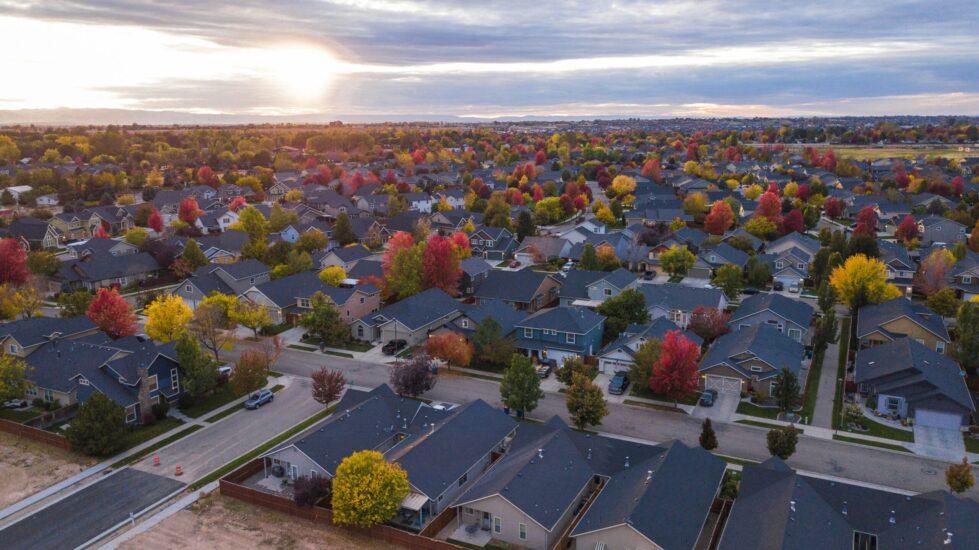- The total value of homes in majority-white neighborhoods grew 5.4% year over year in 2024 to $40.4 trillion. It grew nearly as fast in majority-Black neighborhoods, rising 5.3%.
- Home values also grew in majority-Asian neighborhoods, but at a slightly slower pace; the total value of homes in majority-Hispanic neighborhoods grew the slowest, rising 4.2% to $2 trillion.
- When it comes to individual homes, majority-Hispanic neighborhoods also saw the smallest gain: the average home value increased 3.4%. For comparison, majority-Asian neighborhoods saw the biggest gain, at 4.8%.
The total value of homes in majority-Hispanic neighborhoods rose 4.2% year over year to $2 trillion in 2024. Neighborhoods in which a majority of homeowners are Black, Asian or white—or where there is no racial majority—all saw total home values grow faster.
That’s according to an analysis of Redfin home-value data (from December 31, 2024) in census tracts where more than 50% of owner-occupied homes were owned by Black, Hispanic, Asian or white homeowners. Where no race owned more than 50% of the homes, the area was defined as “mixed.” (See methodology for more details.)
The total value of homes in majority-white neighborhoods grew fastest in 2024, rising 5.4% to $40.4 trillion. The growth rate was essentially the same in majority-Black and majority-Asian neighborhoods: They experienced a 5.3% increase to $1.5 trillion, and 5.2% increase to $1.4 trillion, respectively. The total value of homes in mixed neighborhoods grew 4.7% to $2.4 trillion.
Home values are growing slower in Hispanic neighborhoods because many are located in the Sun Belt, especially Texas and Florida. In those states, home prices have stalled over the past year, due to an increase in supply following the pandemic-driven building boom.
In comparison, home prices are growing fastest in the Northeast and Midwest—areas where majority-white neighborhoods are more prevalent.
Still, the total value of homes in Hispanic neighborhoods is growing, and at a pace not far behind that of other neighborhood types. But slower growth in home values—or even declining home values, in certain areas—can have an outsized impact for Hispanic families.
Redfin Economic Research Lead Chen Zhao said that’s because a larger share of Hispanic households’ net worth tends to be tied to real estate.
Real estate makes up 61.6% of Hispanic households’ net worth, compared to just 27.4% for white households. Real estate makes up 44.1% of Black households’ net worth and 39.5% of “other” households (a group which includes Asian households).
“Hispanic homeowners have experienced higher highs and lower lows during the real estate market’s wild ups and downs over the past 20 years,” Zhao said. “Hispanic home values fell furthest following the global financial crisis in 2008 and they rose the most at the peak of the pandemic homebuying spree in 2021. With a higher share of their net worth tied to real estate, market fluctuations matter more to Hispanic families and can impact how much they can afford to spend or borrow. It also means that when Hispanic home values grow slower, or fall, the wealth gap between white and Hispanic families increases.”
The average value of individual homes in Hispanic neighborhoods also grew slowest in 2024
The average value of individual homes in Hispanic neighborhoods rose 3.4% to $395,000—again slowest among the five groups in this analysis.
Like aggregate home values, the slower growth for average home values is attributable to softening Sun Belt markets where a large number of majority-Hispanic neighborhoods are located.
At the other end of the spectrum, the average home value in majority-Asian neighborhoods nationwide grew 4.8% to $1.13 million—fastest among the five groups. The significantly higher values can be partly attributed to location: Many Asian neighborhoods are located in high-priced West Coast metros, including Los Angeles and San Francisco.
The average value of homes in majority-Black neighborhoods—which, along with white neighborhoods, are generally more geographically dispersed—grew 4.7% year over year to $276,000. Black neighborhoods were the only group analyzed that saw an improved year-over-year growth figure in 2024 (after posting a 4.5% annual increase in 2023).
The average value of homes in majority-white neighborhoods grew 4.7% to $511,000 last year, while homes in mixed neighborhoods grew 3.8% to an average value of $559,000.
Methodology
Home values by race/ethnicity are based on a classification of the home’s census tract. We classified a census tract as Black, Hispanic, Asian or white if more than 50% of owner-occupied households were owned by Black, Hispanic, Asian or white homeowners from 2017 through 2021, according to owner-occupied household race data from the five-year American Community Survey. A census tract was classified as mixed race if no race had greater than 50% of the owner-occupied household share in the tract.
The net worth of households, and the share attributed to real estate, is from the Federal Reserve’s Distribution of Household Wealth in the U.S.
Written by: Mark Worley

